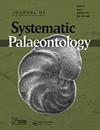Ontogenetic changes in the postcranial skeleton of Mussaurus patagonicus (Dinosauria, Sauropodomorpha) and their impact on the phylogenetic relationships of early sauropodomorphs
IF 2.2
2区 地球科学
Q3 EVOLUTIONARY BIOLOGY
引用次数: 4
Abstract
Early sauropodomorphs were diverse in Gondwana, being particularly well represented in South America. Mussaurus patagonicus is one of the best-known non-sauropod sauropodomorphs that inhabited the Southern Hemisphere. Its importance relies on its phylogenetic position close to Sauropoda and also because it is known from a well-represented ontogenetic series, including embryos, neonate and late immature skeletons, which are particularly scarce among sauropodomorphs. In this regard, Mussaurus represents an excellent opportunity to explore anatomical and palaeobiological constraints during the ontogeny of early stages of the evolution of the group. We present the osteology of the postcranial skeleton of immature specimens of Mussaurus, highlighting the main anatomical changes that occurred during its ontogeny. The phylogenetic position of this taxon based on mature specimens is evaluated through a parsimony analysis, corroborating its position as closer to Sauropoda than most other early sauropodomorphs. Immature stages of this taxon were also evaluated phylogenetically, showing an overall phylogenetic signal that positioned them closer to the root of Sauropodomorpha than the mature specimens. However, the cranial and some postcranial anatomical partitions of neonates and late immature specimens have different phylogenetic signals, showing derived traits present in Sauropoda and related taxa (and supporting the hypothesis of paedomorphic evolution in certain regions of the skeleton). Our analysis shows that most of the appendicular apomorphies in Mussaurus appear late in ontogeny, whereas axial characters (in particular for OS 1), including those of the skull and the presacral vertebrae, show derived character states early in ontogeny that are congruent with the phylogenetic position of mature specimens. Ontogenetic series of other sauropodomorph species, however, are required to test if this pattern applies to the entire group.巴塔哥尼亚Mussaurus patagonicus(恐龙,蜥脚形目)颅后骨骼的个体发生变化及其对早期蜥脚形动物系统发育关系的影响
冈瓦纳大陆早期的蜥脚类恐龙形态多样,在南美洲尤为明显。巴塔哥尼亚Mussaurus patagonicus是南半球最著名的非蜥脚类蜥脚类恐龙之一。它的重要性取决于它与蜥脚下目的亲缘关系,也因为它是从一个代表性很强的个体遗传学系列中已知的,包括胚胎、新生儿和晚期未成熟骨骼,而这些在蜥脚类恐龙中尤其罕见。在这方面,Mussaurus代表了一个绝佳的机会,可以探索该群体进化早期个体发育过程中的解剖学和古生物学约束。我们介绍了Mussaurus未成熟标本的颅后骨骼的骨学,强调了其个体发育过程中发生的主要解剖变化。该分类单元基于成熟标本的系统发育位置通过简约分析进行评估,证实其位置比大多数其他早期蜥脚类恐龙更接近蜥脚目。该分类单元的未成熟阶段也进行了系统发育评估,显示出整体的系统发育信号,使它们比成熟标本更接近蜥脚形目的根。然而,新生儿和晚期未成熟标本的颅骨和一些颅后解剖分区具有不同的系统发育信号,显示出蜥脚下目和相关分类群中存在的衍生特征(并支持骨骼某些区域的恋童形态进化假说)。我们的分析表明,Mussaurus的大多数阑尾变形出现在个体发育后期,而轴向特征(尤其是OS 1),包括头骨和骶前椎骨的轴向特征,显示出个体发育早期的衍生特征状态,与成熟标本的系统发育位置一致。然而,其他蜥脚类物种的个体发生序列需要测试这种模式是否适用于整个群体。
本文章由计算机程序翻译,如有差异,请以英文原文为准。
求助全文
约1分钟内获得全文
求助全文
来源期刊
CiteScore
5.30
自引率
7.70%
发文量
31
审稿时长
>12 weeks
期刊介绍:
The Journal of Systematic Palaeontology publishes papers that provide novel and impactful results in phylogenetics and systematics and that use these results in ways that significantly advance rigorous analyses of palaeogeography, palaeobiology, functional morphology, palaeoecology or biostratigraphy. Papers dealing with theoretical issues or molecular phylogenetics are also considered if they are of relevance to palaeo-systematists. Contributions that include substantial anatomical descriptions, descriptions of new taxa or taxonomic revisions are welcome, but must also include a substantial systematics component, such as a new phylogeny or a revised higher-level classification. Papers dealing primarily with alpha-taxonomic descriptions, the presentation of new faunal/floristic records or minor revisions to species- or genus-level classifications do not fall within the remit of the journal.

 求助内容:
求助内容: 应助结果提醒方式:
应助结果提醒方式:


